What Is A Capture Page?

Here is an example of a capture page. It is designed to attract people to your email marketing list. It's how you catch the “big fish.” the people who buy from you again and again. This page will have a singular focus and direct people to a specific list. From there, you can find what their interests are and tailor their ongoing experience to those interests.
Some people call it a squeeze page because they are “squeezing” people for their information. There's no choice but fill out or don't fill out. To me, squeeze page just doesn't sound right. I don't want to squeeze people or have them feel like they've been squeezed when they hear the term.
You might have also heard the term landing page. That doesn't clearly define the purpose of the page. Just because it is a landing page, doesn't mean you're capturing information. You can use a landing page to show a variety of options where clicking on each option takes them to a capture page. That helps segment up front. Here's an example of a landing page.
The term capture page explains precisely what the purpose of the page is, capturing the contact information of people interested in your products/services.
A capture page can also be used to have people sign up for an event tied to an “Interest based list.” This could be an online training video, a live webinar, or even a physical meeting.
The key is not giving up after the first sale, event attended, action taken, etc. but in following up with more related information and offers that that person will find helpful. That is why you use the capture page to get their information and the email marketing component to follow up.
Your email marketing messages would start out their life as posts on your website. Subscribers reading your email message would be directed to “read more” on the site. On the page, there would be a Call To Action (CTA) to comment. That gets interaction between you and the people on your list beyond just email. It also adds to social proof. Other people will see the comments and some will add to the conversation or even subscribe to get more of your great content.
Let's be clear
A contact page is NOT a capture page. The contact page cannot deliver anything more than a general “Thank you, I'll be in touch” message. Why? Because you can't possibly set it up specifically for anything.
More importantly, your contact page doesn't say what the prospect is contacting you about when they don't leave a detailed message. Let's face it, these can be vague at the best of times.
What a capture page does, is place the prospect on a defined path. It allows you to deliver specific information along with a follow up process that is automatic. When connected to an Intelligent follow up system, your prospect is taken along a path from visitor, to prospect, to customer, to repeat customer. All with minimal or no interaction required until you know you're dealing with a ready to buy lead.
So how do you get sales from this?
Everything I have mentioned so far builds three essential components you must have in place before you can make a sale: Know, Like, and Trust.
Once they get to know you, like you, and trust you, the offers you send will make sense for them to buy.
That can take some time. That's the beauty of online marketing. You're building a Know, Like, and Trust asset, not investing time, effort, and money in individual prospects. People come in on their time and warm up to you in their time. As long as they stay on the list, they will continue to get the messages until one day that message strikes the right chord. And then, you have a customer who believes in you and what you offer. It all starts with the capture page.
Rob Calhoun
Latest posts by Rob Calhoun (see all)
- Fresh Content: Updating Blog Posts Do's & Don'ts - January 23, 2020
- List Hygiene Gone Wild - July 1, 2019
- What Domino's Knows About Lead Generation - February 5, 2019
- Don’t Try To Bury Bad Customer Reviews - August 18, 2017
- More Important Than Money - November 3, 2016

